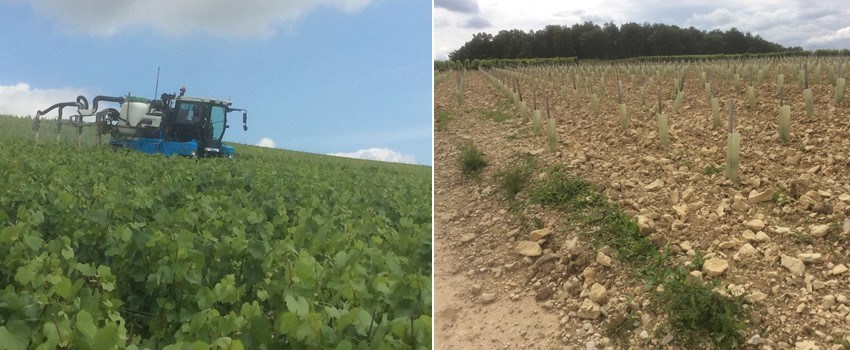Climate has never been reliable here, 2015 seeing days of 40°C and Chardonnay wines of power and depth and 2016 having better balance and finesse. But there is another, scarier side to living life on the winemaking edge, and Chablis has already experienced it.
Such unpredictability has unsettled wine producers. Now there is no standard practice, no set dates, no routine.
This year is a good example. “So far, so good”, says Sebastian Dampt of the Daniel Dampt house, “but things could go very badly”. He has painful memories of 2016, when they lost half of their crop to frost. As we talked, outside it was overcast, rain was coming, being mid June berries were visible and looking vulnerable. “If we get a storm now..” he says.
Recent years have seen loses for various reasons, mainly frost. Domaine Laroche estimate that in the last three years they have lost one full vintage worth of crop. Domaine William Fèvre lost two thirds of their grapes in 2016, despite as a precaution spraying the vines before the frost (water freezes at 0° protecting the vines if the temperature drops below that), it didn’t help. Neither did vineyard oil heaters.
Battle weary Domaine Laroche say there are only two solutions to frost, pray and drink. The story is the same at Domaine Pinson, they lost half of their crop in 2016 and half again in 2017. “Do you need a big year to catch up?”, I ask, “we don’t need a good year, please, just a normal year”.
This year, so far there have been warm and humid days, hence lots of spraying, and leaf plucking is continuing in earnest, vines are in overdrive, “It’s like a jungle out there”, says William Fèvre. It is looking ‘magnifique’ - so far - but every day breaths are collectively being held.

The madness has affected everything the winegrowers do; harvest, traditionally at the end of September, could be the end of August this year. And, Sacré Bleus, the panic to avoid disaster has seen machine harvesting in Grand Cru Vineyards. Not allowed, frowned upon, but a winemaker swears there was a machine at work in 2017 in Les Preuses vineyard.
Everywhere, at every appellation level, wines are at 12.5% alcohol, exactly. How is that possible with such varying summers? I ask, do you vary harvest times, or make adjustments? Nowhere did I get an answer. La Malady.
Perhaps even madder, very few producers engage in any grape sorting before fermentation, the belief that if it is from a Grand or Premier Cru vineyard it must be good regardless. Luckily, they seem correct.
Read part 2 of Dave's travels in France next week
Visit the Stellenbosch Wine Review